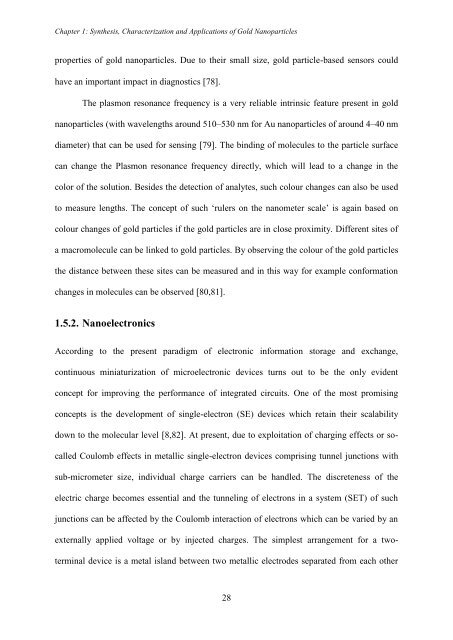PHYS01200704032 Debes Ray - Homi Bhabha National Institute
PHYS01200704032 Debes Ray - Homi Bhabha National Institute
PHYS01200704032 Debes Ray - Homi Bhabha National Institute
Create successful ePaper yourself
Turn your PDF publications into a flip-book with our unique Google optimized e-Paper software.
Chapter 1: Synthesis, Characterization and Applications of Gold Nanoparticles<br />
properties of gold nanoparticles. Due to their small size, gold particle-based sensors could<br />
have an important impact in diagnostics [78].<br />
The plasmon resonance frequency is a very reliable intrinsic feature present in gold<br />
nanoparticles (with wavelengths around 510–530 nm for Au nanoparticles of around 4–40 nm<br />
diameter) that can be used for sensing [79]. The binding of molecules to the particle surface<br />
can change the Plasmon resonance frequency directly, which will lead to a change in the<br />
color of the solution. Besides the detection of analytes, such colour changes can also be used<br />
to measure lengths. The concept of such „rulers on the nanometer scale‟ is again based on<br />
colour changes of gold particles if the gold particles are in close proximity. Different sites of<br />
a macromolecule can be linked to gold particles. By observing the colour of the gold particles<br />
the distance between these sites can be measured and in this way for example conformation<br />
changes in molecules can be observed [80,81].<br />
1.5.2. Nanoelectronics<br />
According to the present paradigm of electronic information storage and exchange,<br />
continuous miniaturization of microelectronic devices turns out to be the only evident<br />
concept for improving the performance of integrated circuits. One of the most promising<br />
concepts is the development of single-electron (SE) devices which retain their scalability<br />
down to the molecular level [8,82]. At present, due to exploitation of charging effects or socalled<br />
Coulomb effects in metallic single-electron devices comprising tunnel junctions with<br />
sub-micrometer size, individual charge carriers can be handled. The discreteness of the<br />
electric charge becomes essential and the tunneling of electrons in a system (SET) of such<br />
junctions can be affected by the Coulomb interaction of electrons which can be varied by an<br />
externally applied voltage or by injected charges. The simplest arrangement for a twoterminal<br />
device is a metal island between two metallic electrodes separated from each other<br />
28

















